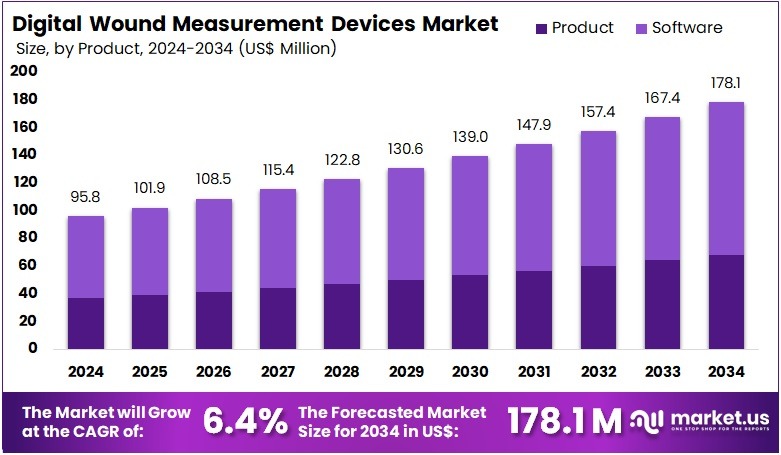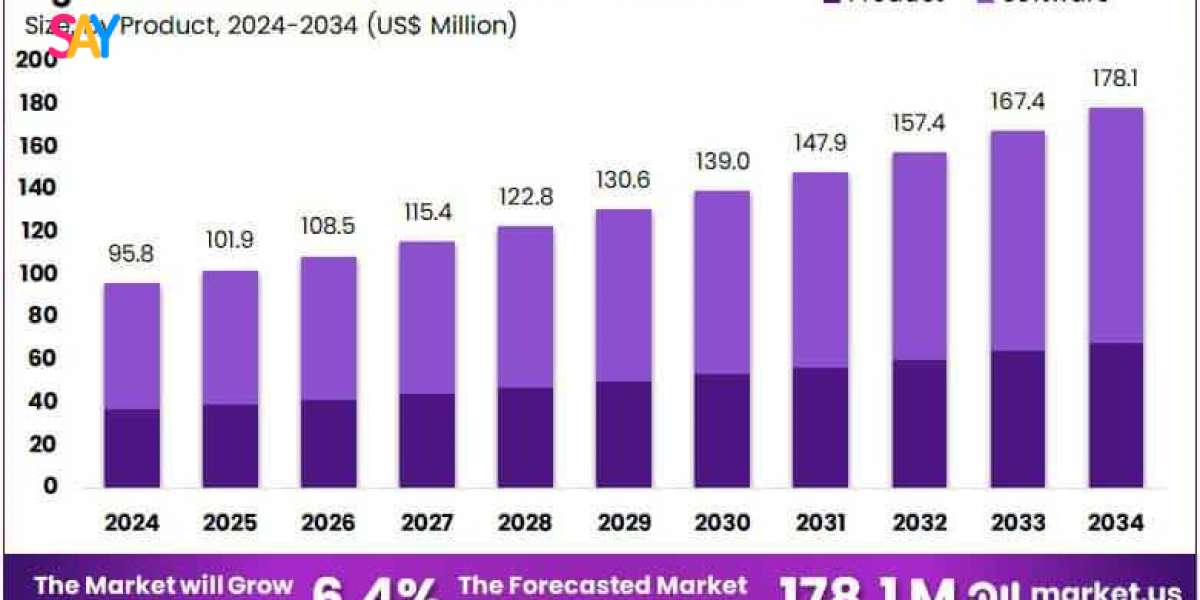The digital wound measurement devices market is expected to reach around US$ 178.1 million by 2034, up from US$ 95.8 million in 2024, growing at a CAGR of 6.4% during the forecast period. This steady growth is mainly due to the rising burden of chronic wounds across the globe. According to the World Health Organization (WHO), chronic diseases such as diabetes and vascular disorders are becoming more common. These conditions often result in slow-healing wounds like diabetic foot ulcers. Digital tools provide accurate wound size tracking, which helps doctors plan better treatments and monitor healing progress.
Healthcare systems are also focusing more on quality improvement and patient safety. Many governments are promoting digital health adoption through policy support. For example, the U.S. Department of Health and Human Services has launched initiatives to boost the use of digital tools in healthcare. Digital wound measurement devices help reduce treatment errors and support evidence-based care. Their consistent measurements aid clinicians in making accurate decisions, improving overall outcomes and minimizing complications.
Infection control is another strong factor behind market growth. According to the Centers for Disease Control and Prevention (CDC), healthcare-associated infections remain a significant challenge. Digital wound tools reduce the need for physical contact, helping prevent infection spread. This feature gained particular importance during the COVID-19 pandemic, as hospitals needed to limit face-to-face contact between patients and providers while still ensuring care quality.
Finally, the rise in electronic health record (EHR) systems supports the market. Digital wound measurement devices can easily connect with EHR platforms, helping providers store, access, and share wound data securely. This connectivity enhances communication between medical teams and speeds up treatment planning. The increasing use of digital health infrastructure across many countries creates a favorable environment for these devices

Key Takeaways
- In 2024, the Digital Wound Measurement Devices Market earned US$ 95.8 million and is projected to reach US$ 178.1 million by 2034.
- The market is growing at a CAGR of 6.4%, driven by rising chronic wound cases and advancements in wound care technologies.
- The product type segment includes Product and Software, with Software dominating the market in 2024 by holding a 61.7% share.
- Based on wound type, Chronic Wounds led the market in 2024, accounting for a significant 74.2% of the overall revenue.
- When categorized by technique, 3D wound measurement took the lead globally in 2024, capturing a 65.2% market share.
- Hospitals emerged as the top end-user segment in 2024, holding the highest share of 41.9% in market revenue.
- Among all regions, North America led the global market in 2024 with a commanding 38.5% share of total revenue.
Emerging Trends
1. Growing Use of AI for Wound Analysis
Artificial intelligence (AI) is making wound measurement more accurate. These devices now detect wound size, depth, and healing stage faster than before. AI helps healthcare workers make better decisions based on clear, consistent results. It also reduces the chances of human error. With AI, doctors can track how well a wound is healing over time. This leads to more personalized treatment. It also saves time during hospital rounds. AI-supported wound analysis is expected to become even more common in both hospitals and clinics.
2. Smartphone Integration
Smartphones are now being used to scan and measure wounds. Many digital tools work through simple mobile apps. Nurses and doctors can take wound images using their phones and get instant analysis. This makes wound care faster and more mobile. It’s also useful in rural or remote areas where advanced tools might not be available. By using a smartphone, healthcare providers can carry powerful wound assessment tools in their pocket. It also helps reduce costs and improve convenience for patients and staff.
3. Cloud-Based Data Storage
Wound data is now stored safely in the cloud. Devices capture images and track healing progress over time. This information is saved online so healthcare workers can access it from anywhere. It allows doctors to compare changes in wound size or shape easily. Sharing data with specialists also becomes simple and fast. Cloud storage also helps avoid the loss of patient records. It improves communication between care teams and supports better treatment planning. More providers are adopting cloud solutions to manage wound care effectively.
4. Telemedicine Support
Digital wound devices now support telemedicine features. Patients can scan their wounds from home using mobile tools. The data is then shared with doctors online. This reduces the need for frequent hospital visits. It is especially useful for elderly patients or those with mobility issues. Doctors can check the progress and offer advice without an in-person visit. This saves time for both patients and healthcare workers. Remote wound monitoring also helps during emergencies or lockdowns when access to care is limited.
5. 3D Wound Imaging Technology
New devices are using 3D imaging to study wounds more deeply. This technology gives a clearer view of wound depth and tissue structure. It helps doctors plan better treatments by showing exactly how the wound is healing. 3D images offer more detail than regular photos. This improves the chances of fast and full recovery. It also allows for better tracking of wound changes. Hospitals and advanced care centers are now beginning to use 3D wound scanners more often.
GET SAMPLE REPORT : https://market.us/report/global-digital-wound-measurement-devices-market/request-sample/
Use Cases
Monitoring Diabetic Foot Ulcers
People with diabetes are at high risk of developing foot ulcers. These wounds can get worse quickly if not managed properly. Digital wound measurement devices help doctors and nurses track the size and depth of these wounds over time. They allow for better care planning and timely treatment. With accurate tracking, healthcare providers can spot early signs of infection. This helps prevent serious complications like gangrene or amputation. These devices also make it easier to share wound data between specialists. This ensures the patient receives the best care without delay.
Treating Pressure Injuries in Elderly Patients
Older adults, especially those who are bedridden, often suffer from pressure ulcers. These wounds form due to long hours of lying or sitting without movement. Caregivers use digital wound measurement tools to check the wounds regularly. This helps track healing and change treatment if needed. The tools reduce guesswork and improve care quality. Early detection of any worsening signs helps avoid infections or skin breakdown. These devices also support home healthcare providers in giving better wound care. Regular monitoring ensures faster healing and fewer hospital visits.
Wound Care in Burn Units
Burn injuries need very accurate care and tracking. Doctors rely on digital devices to measure burn depth, wound size, and healing progress. These tools give clear and repeatable measurements, which are critical for planning skin grafts or surgeries. They also help compare results over time to see if the treatment is working. In busy hospital burn units, these devices save time and improve decision-making. They also reduce errors that can happen with manual measurements. Patients benefit from quicker recovery and more precise care.
Post-Surgery Wound Monitoring
After surgery, it is very important to check how the wound is healing. Digital wound measurement devices help nurses and doctors monitor surgical wounds closely. These tools can detect early signs of infection, such as swelling or delayed healing. Regular and accurate tracking helps avoid serious issues. Patients recover faster because treatment changes can be made quickly if needed. These tools are also useful for sending wound updates to surgeons who are not on-site. This makes post-operative care safer and more efficient.
Military and Emergency Care Settings
In military zones or emergency disaster areas, wound care can be a big challenge. Medical teams often have limited tools and time. Digital wound measurement devices offer quick and reliable data. They help assess injuries in seconds, even in rough conditions. These devices work well in mobile clinics and field hospitals. They help make fast decisions for treatment and improve patient outcomes. The ability to store and share wound data is also helpful when patients are moved between care centers. This ensures they get the right care at every step.
Conclusion
In conclusion, the digital wound measurement devices market is growing steadily as healthcare systems shift toward more advanced, data-driven care. These devices help doctors and nurses measure wounds more accurately, which leads to better treatment and faster healing. They are especially useful for managing chronic conditions, supporting elderly care, and improving safety in hospitals and remote settings. With more use of smartphones, cloud storage, and AI, digital tools are becoming easier to use and more widely accepted.




